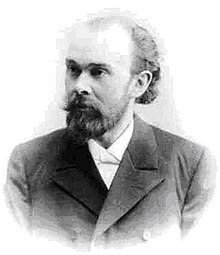Illarion Ivanov-Schitz
| Illarion Aleksandrovich Ivanov-Schitz | |
|---|---|
 |
|
| Born | March 28, 1865 Mikhailovka, Voronezh Oblast |
| Died | December 7, 1937 (aged 72) Moscow |
| Nationality | Russia |
| Occupation | Architect |
| Practice | Own firm |
| Buildings | Lenkom Theatre Courses for the Women in Devichye Pole Morozov Hospital |
| Projects | Miusskaya Square public buildings |
Illarion Aleksandrovich Ivanov-Schitz (Russian: Илларион Александрович Иванов-Шиц; 1865 – 1937) was a Russian architect, notable for developing a unique personal style, blending the Vienna Secession school of Otto Wagner with Greek Revival features. His career peaked in 1902-1912 with several Moscow buildings including the Morozov Hospital, the Merchant Club (now the Lenkom Theatre), Moscow Savings Bank, and the public buildings in Miusskaya Square. He was one of the few architects born in the 1860s who integrated into the Soviet establishment, earning the Order of Lenin for various resort projects and for redesigning the interiors of the Grand Kremlin Palace in the 1930s.
Ivanov-Schitz graduated from the Saint Petersburg Institute of Civil Engineers, which he attended from 1883–1888, with a gold medal. After a brief tour of Europe, he relocated to Moscow, joining the firm of Max Hoppener and later working for the City of Moscow. Another visit to Europe, in 1893, exposed him to Austrian architect Otto Wagner and his circle, who would form the Vienna Secession group in 1897.
His first realised design, co-signed by Vladimir Sherwood (Jr.), was an 1889 apartment building at 32 Tverskaya Street, Moscow (destroyed). His early works, such as the orphanage in Devichye Pole (1893), now housing Embassy of Vietnam, belong to the tradition of 19th century eclecticism, and do not stand out among hundreds of similar buildings. Over the first decade of his career, Ivanov-Schitz' style gradually moved towards Greek Revival. Collaboration with Lev Kekushev on his railroad projects and public buildings also exposed Ivanov-Schitz to practical applications of Kekushev's Belgian-inspired variety of Art Nouveau.
...
Wikipedia
